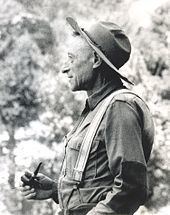Name Carl Sharsmith | Role Botanist | |
 | ||
Died October 14, 1994, San Jose, California, United States | ||
Carl W. Sharsmith (March 14, 1903 – October 14, 1994) was an American naturalist and Yosemite park ranger, notable for his knowledge and interpretation of the natural history of the Sierra Nevada. He taught botany at various universities, and was the first botanist to comprehensively document the alpine flora of the high Sierra Nevada.
Contents
Biography
Born Karl Wilhelm Schaarschmidt II in New York City to Swiss and German parents, he grew up the U.S., Europe, and Canada. Sharsmith was inspired by the works of naturalist John Muir and became interested in the outdoors and nature. He dropped out of school at 14, but became inspired enough to finish his high school and college education.
Sharsmith enrolled in the Yosemite School of Field Natural History in 1930 then was hired as a seasonal Ranger-Naturalist in Tuolumne Meadows, Yosemite National Park the following year.
He received his BA from the University of California, Los Angeles in 1933, and his Ph.D. in botany from the University of California, Berkeley in 1940.
Sharsmith would work each summer as a Ranger-Naturalist and spend the rest of the year teaching or performing herbarium research. He was said to have explored nearly every "nook and cranny" of Yosemite's High Sierra
The rest of the year he taught or researched at various schools, that included Stanford University, the University of Minnesota, and San Jose State University. Sharsmith was Professor of Botany at San Jose State from 1950 to 1973.
On his opinion of teaching he said, "people are not interested in facts. The greater appeal is to the heart." On nature walks, he would often kneel down and talk about a flower. One of his favorite flowers was Raggedy Aster (Aster integrifolius). When asked what he would do if he only had a day to see Yosemite he replied, "I'd sit by the Merced River and cry."
Besides interpreting for visitors, Sharsmith did basic research on the alpine meadows of the High Sierra, gathering thousands of herbarium specimens, and publishing several research papers.
Sharsmith retired from the National Park Service in 1993 at 90, the oldest active NPS park ranger in history.
Personal life
Helen K. Sharsmith, his wife, was a biologist and botanist with a Ph.D. from UC Berkeley. They had a son John, named after John Muir, and a daughter Linnea, named after Carl Linnaeus. Sharsmith and his wife later divorced.
His interests included botany, zoology, geology, classical music, Shakespeare, and singing opera.
Carl Sharsmith died 1994 in his home at San Jose, California.
